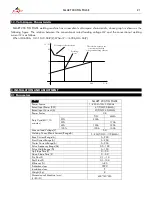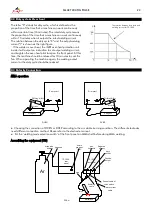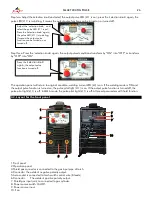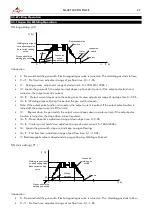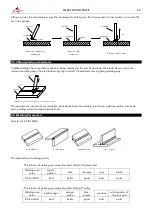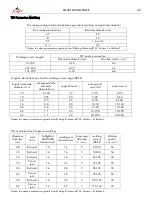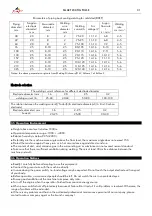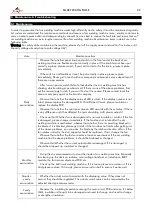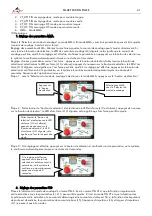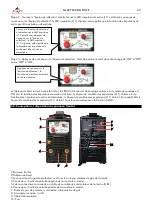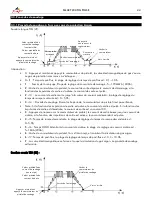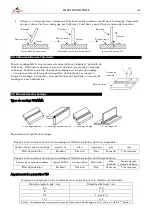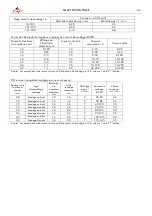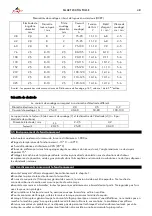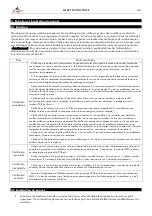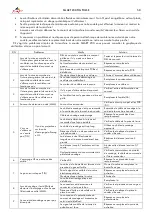
SMART 200 TIG PULSE
35
•
Never simultaneously touch electrically “hot” parts of electrode holders connected to two welders because voltage
between the two can be the total of the open circuit voltage of both welders.
•
When working above floor level, use a safety belt to protect yourself from a fall should you get a shock.
FUMES AND GASES CAN BE DANGEROUS.
•
Welding may produce fumes and gases hazardous to health. Avoid breathing these fumes and gases. When
welding, keep your head out of the fume. Use enough ventilation and/or exhaust at the arc to keep fumes and
gases away from the breathing zone. When welding with electrodes which require special ventilation such as
stainless or hard facing or on lead or cadmium plated steel and other metals or coatings which produce highly
toxic fumes, keep exposure as low as possible and below Threshold Limit Values using local exhaust or
mechanical ventilation. In confined spaces or in some circumstances, outdoors, a respirator may be required.
Additional precautions are also required when welding on galvanized steel.
•
Do not weld in locations near chlorinated hydrocarbon vapors coming from degreasing, cleaning or spraying
operations. The heat and rays of the arc can react with solvent vapors to form phosgene, a highly toxic gas, and
other irritating products.
•
Shielding gases used for arc welding can displace air and cause injury or death. Always use enough ventilation,
especially in confined areas, to insure breathing air is safe.
•
Read and understand the manufacturer’s instructions for this equipment and the consumables to be used,
including the material safety data sheet and follow your employer’s safety practices.
ARC RAYS CAN BURN.
•
Use a shield with the proper filter and cover plates to protect your eyes from sparks and the rays of the arc when
welding or observing open arc welding.
•
Use suitable clothing made from durable flame-resistant material to protect your skin and that of your helpers
from the arc rays.
•
Protect other nearby personnel with suitable, non-flammable screening and /or warn them not to watch the arc
nor expose themselves to the arc rays or to hot spatter or metal.
SELF-PROTECTION
•
Keep all equipment safety guards, covers and devices in position and in good repair. Keep hands, hair, clothing
and tools away from V-belts, gears, fans and all other moving parts when starting, operating or repairing
equipment.
•
Do not put your hands near the engine fan. Do not attempt to override the governor or idler by pushing on the
throttle control rods while the engine is running.
DO NOT
adds the fuel near an open flame welding arc or when the engine is running. Stop
the engine and allow it to cool before refueling to prevent spilled fuel from vaporizing on contact with hot engine parts
and igniting. Do not spill fuel when filling tank. If fuel is spilled, wipe it up and do not start engine until fumes have
been eliminated.
WELDING SPARKS can cause fire or explosion
•
Remove fire hazards from the welding area. If this is not possible, cover them to prevent the welding sparks from
starting a fire. Remember that welding sparks and hot materials from welding can easily go through small cracks
and openings to adjacent areas. Avoid welding near hydraulic lines. Have a fire extinguisher readily available.
•
Where compressed gases are to be used at the job site, special precautions should be used to prevent hazardous
situation.
•
When not welding, make certain no part of the electrode circuit is touching the work or ground. Accidental
contact can cause overheating and create a fire hazard.
•
Do not heat, cut or weld tanks, drums or containers until the proper steps have been taken to insure that such
procedures will not cause flammable or toxic vapors from substances inside. They can cause an explosion even
though they have been “cleaned”.
Vent hollow castings or containers before heating, cutting or welding. They may explode.

